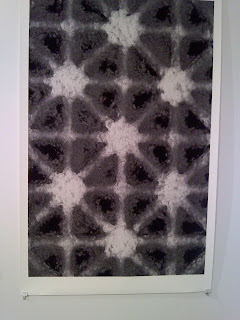The first year MFA exhibition turned out to be an interesting show. The show was hung well, clean, simple, and well spaced. From a curatorial standpoint, most of the rooms seemed to flow nicely. I commend their efforts to create a professional looking show. However, I did not like the method in which they chose to display the artists’ names. Whenever I walk into a gallery, I typically pick up the press release on my way out so that I am not carrying around pieces of paper while looking at the artwork. This also allows me to reflect on the work of the show before seeing what the gallery’s goals for the show are. So when I first walked in, I did not even see the map on the table. As I was walking through the show I kept wondering who the artists were and why the MFA students had decided not to include the names. Typically when I go to a show, I will write down the artist’s name or the name of the piece so that I can refer back to it later, however it was difficult to do for this show. Since I have worked in that gallery for this class, and know the layout, I was able to decipher from the many pictures I have taken that include the orientation and layout of the rooms, the names and titles of the pieces. I do however, think that the design of the map and the color chosen for the sign were nice. The title of the show is simple and appropriate; the audience is obviously here, at the show. Since this is an exhibition displaying the talent of the MFA students, “here I am” is a statement that is perhaps saying “this is me, this is my artwork, here I am for you to view.”
 |
| Doug McLean "Untilled" |
One of the grad students came in and critiqued my classes’ paintings because my teacher was absent. After looking at my artwork, he told me to view the artwork of Doug McLean. His work relates to my current paintings in the level of abstraction and simplicity. McLean has abstracted a pumpkin into flat simple shapes. His palette for this set of paintings is very restricted. He predominantly uses two colors in each of these paintings. Then, he creates a shade of each of these colors. What makes these paintings interesting is that the intensity and value of each color is the same.
 |
| Doug McLean "Untilled" |
 |
| Doug McLean "Untilled" |
The light red is the same intensity as the light purple and the dark red is the same intensity as the dark purple. I am unsure of his process, but I wonder if he did these paintings simultaneously and used the same palette for each painting. Throughout the paintings there are similar reds and purples and if they were done concurrently this allows for the manipulation of the colors. It is interesting to see what happens when the red is placed on a dark background, then in the foreground, then in the negative space and how that red changes depending on the colors it next to. This is a concept that I am working on in my own paintings. I want to continue to explore the relationships of color through placement and space, which is a concept McLean seems to be working on. I was happy to see this type of work in the show, and overall satisfied with the show in general. However, I was pretty disappointed in the amount of photography in the show, or perhaps photographers in the program. Since I am a photograph major, it is always nice to look at the work of others in similar programs.

































